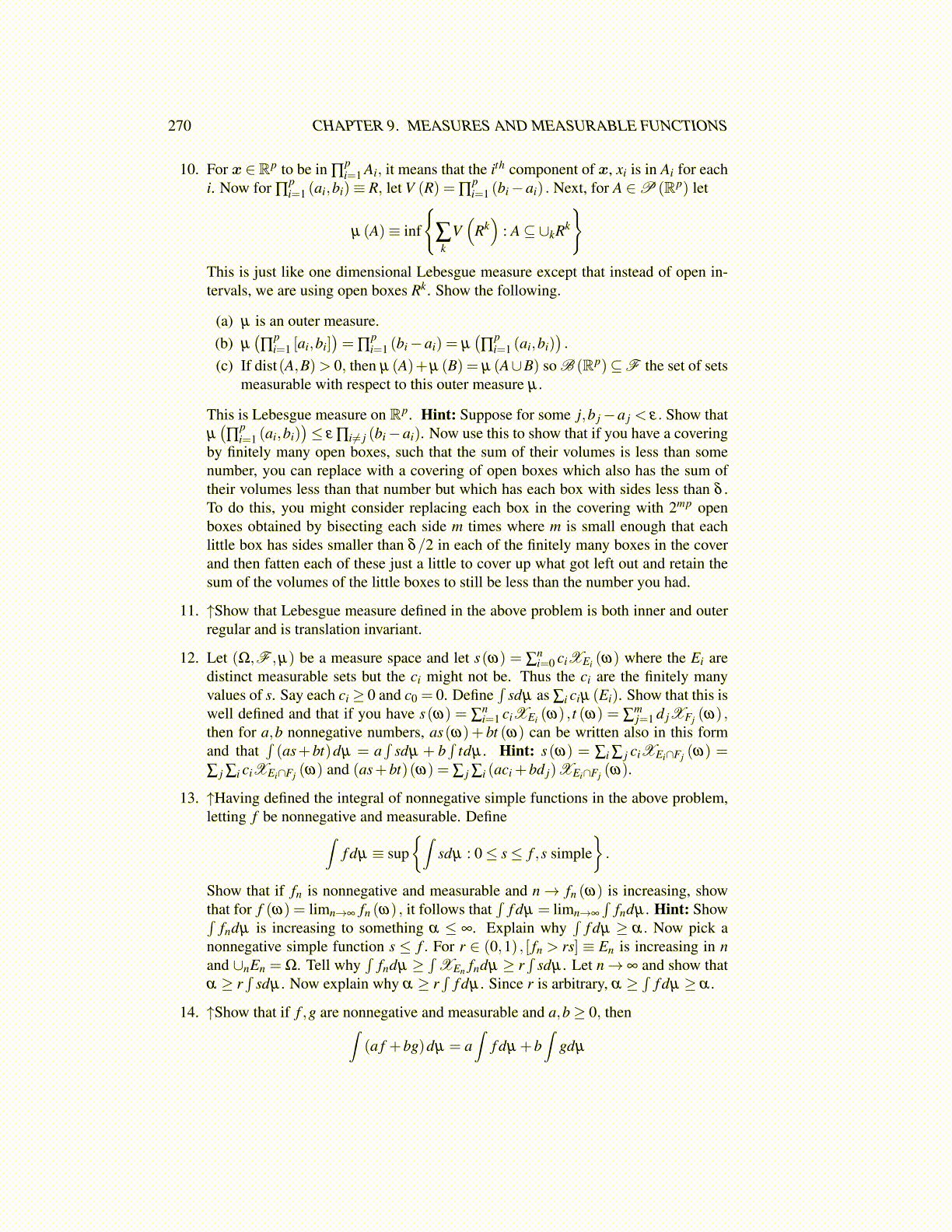
270 CHAPTER 9. MEASURES AND MEASURABLE FUNCTIONS
10. For x ∈Rp to be in ∏pi=1 Ai, it means that the ith component of x, xi is in Ai for each
i. Now for ∏pi=1 (ai,bi)≡ R, let V (R) = ∏
pi=1 (bi−ai) . Next, for A ∈P (Rp) let
µ (A)≡ inf
{∑k
V(
Rk)
: A⊆ ∪kRk
}This is just like one dimensional Lebesgue measure except that instead of open in-tervals, we are using open boxes Rk. Show the following.
(a) µ is an outer measure.(b) µ
(∏
pi=1 [ai,bi]
)= ∏
pi=1 (bi−ai) = µ
(∏
pi=1 (ai,bi)
).
(c) If dist(A,B)> 0, then µ (A)+µ (B) = µ (A∪B) so B (Rp)⊆F the set of setsmeasurable with respect to this outer measure µ .
This is Lebesgue measure on Rp. Hint: Suppose for some j,b j−a j < ε. Show thatµ(∏
pi=1 (ai,bi)
)≤ ε ∏i ̸= j (bi−ai). Now use this to show that if you have a covering
by finitely many open boxes, such that the sum of their volumes is less than somenumber, you can replace with a covering of open boxes which also has the sum oftheir volumes less than that number but which has each box with sides less than δ .To do this, you might consider replacing each box in the covering with 2mp openboxes obtained by bisecting each side m times where m is small enough that eachlittle box has sides smaller than δ/2 in each of the finitely many boxes in the coverand then fatten each of these just a little to cover up what got left out and retain thesum of the volumes of the little boxes to still be less than the number you had.
11. ↑Show that Lebesgue measure defined in the above problem is both inner and outerregular and is translation invariant.
12. Let (Ω,F ,µ) be a measure space and let s(ω) = ∑ni=0 ciXEi (ω) where the Ei are
distinct measurable sets but the ci might not be. Thus the ci are the finitely manyvalues of s. Say each ci ≥ 0 and c0 = 0. Define
∫sdµ as ∑i ciµ (Ei). Show that this is
well defined and that if you have s(ω) = ∑ni=1 ciXEi (ω) , t (ω) = ∑
mj=1 d jXFj (ω) ,
then for a,b nonnegative numbers, as(ω)+ bt (ω) can be written also in this formand that
∫(as+bt)dµ = a
∫sdµ + b
∫tdµ . Hint: s(ω) = ∑i ∑ j ciXEi∩Fj (ω) =
∑ j ∑i ciXEi∩Fj (ω) and (as+bt)(ω) = ∑ j ∑i (aci +bd j)XEi∩Fj (ω).
13. ↑Having defined the integral of nonnegative simple functions in the above problem,letting f be nonnegative and measurable. Define∫
f dµ ≡ sup{∫
sdµ : 0≤ s≤ f ,s simple}.
Show that if fn is nonnegative and measurable and n→ fn (ω) is increasing, showthat for f (ω) = limn→∞ fn (ω) , it follows that
∫f dµ = limn→∞
∫fndµ . Hint: Show∫
fndµ is increasing to something α ≤ ∞. Explain why∫
f dµ ≥ α. Now pick anonnegative simple function s ≤ f . For r ∈ (0,1) , [ fn > rs] ≡ En is increasing in nand ∪nEn = Ω. Tell why
∫fndµ ≥
∫XEn fndµ ≥ r
∫sdµ . Let n→ ∞ and show that
α ≥ r∫
sdµ . Now explain why α ≥ r∫
f dµ . Since r is arbitrary, α ≥∫
f dµ ≥ α .
14. ↑Show that if f ,g are nonnegative and measurable and a,b≥ 0, then∫(a f +bg)dµ = a
∫f dµ +b
∫gdµ